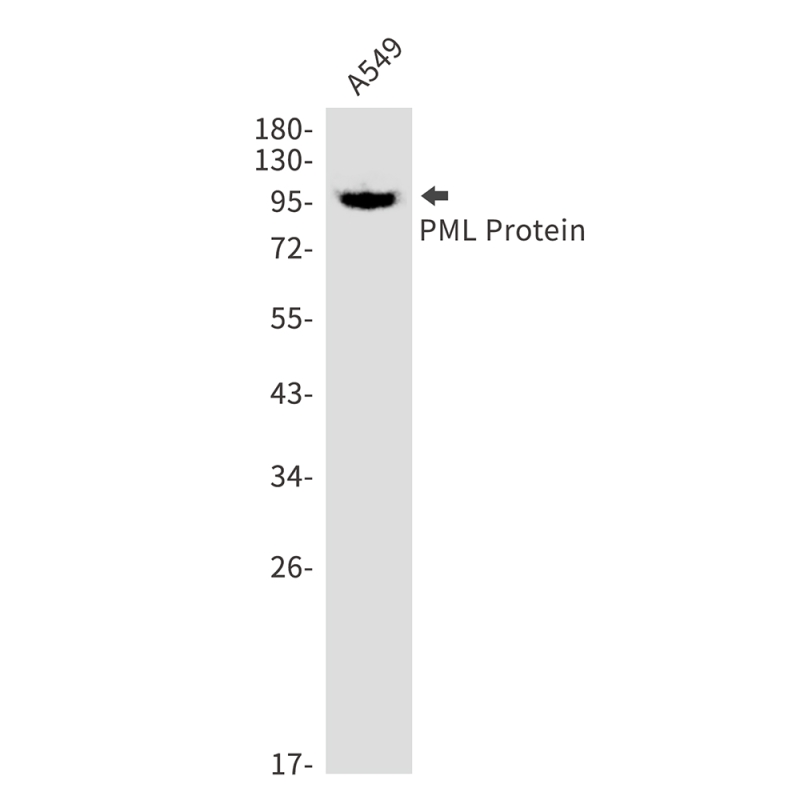
| WB | 1/500-1/1000 | Human,Mouse,Rat |
| IF | 1/20 | Human,Mouse,Rat |
| IHC | 1/50-1/100 | Human,Mouse,Rat |
| ICC | 1/50-1/200 | Human,Mouse,Rat |
| FCM | 咨询技术 | Human,Mouse,Rat |
| Elisa | 咨询技术 | Human,Mouse,Rat |
| Aliases | PML; MYL; RNF71; TRIM19; Protein PML; Promyelocytic leukemia protein; RING finger protein 71; Tripartite motif-containing protein 19 |
| Entrez GeneID | 5371 |
| WB Predicted band size | Calculated MW: 98 kDa; Observed MW: 98,117 kDa |
| Host/Isotype | Rabbit IgG |
| Antibody Type | Primary antibody |
| Storage | Store at 4°C short term. Aliquot and store at -20°C long term. Avoid freeze/thaw cycles. |
| Species Reactivity | Human |
| Immunogen | A synthetic peptide of human PML Protein |
| Formulation | Purified antibody in TBS with 0.05% sodium azide,0.05%BSA and 50% glycerol. |
+ +
以下是3-4篇关于PML蛋白抗体的参考文献及其摘要概括:
1. **文献名称**:*The PML protein associates with the nuclear matrix in HL-60 cells and is redistributed during apoptosis*
**作者**:Koken, M.H.M. 等 (1995)
**摘要**:该研究利用抗PML抗体揭示了PML蛋白在HL-60细胞核基质中的定位,并发现其在细胞凋亡过程中会从核内结构(PML核体)重新分布至细胞质,提示PML在细胞死亡调控中的作用。
2. **文献名称**:*Role of PML in tumor suppression and antiviral response*
**作者**:Salomoni, P. & Pandolfi, P.P. (2002)
**摘要**:通过特异性抗体检测,文章阐明了PML蛋白在抑制肿瘤发生(如通过调控p53通路)及参与天然抗病毒免疫中的双重功能,并强调了PML核体的动态结构变化。
3. **文献名称**:*PML isoforms and their role in oncogenic transformation*
**作者**:Jensen, K. 等 (2001)
**摘要**:研究利用多种PML抗体鉴定了不同PML蛋白亚型,发现特定亚型(如PML-I和PML-IV)在抑制细胞增殖和诱导衰老中的差异功能,为PML的肿瘤抑制机制提供了分子依据。
4. **文献名称**:*Antibody-based analysis of PML nuclear body composition and dynamics*
**作者**:Dellaire, G. 等 (2006)
**摘要**:通过免疫荧光和免疫电镜结合抗PML抗体,系统分析了PML核体的组成蛋白(如Sp100、DAXX)及其在DNA损伤应答中的动态重组过程。
**备注**:以上文献发表于《Experimental Cell Research》《Oncogene》《Journal of Cell Science》等期刊,涉及抗体在定位、功能研究和疾病机制中的应用。若需具体实验方法(如抗体克隆号或应用场景),可进一步补充说明。
The Promyelocytic Leukemia (PML) protein, encoded by the *PML* gene, is a tumor suppressor and key component of PML nuclear bodies (PML-NBs), dynamic subnuclear structures involved in diverse cellular processes. These include apoptosis, DNA damage response, antiviral defense, and transcriptional regulation. PML regulates these functions by recruiting partner proteins (e.g., p53. DAXX, SP100) to PML-NBs, facilitating post-translational modifications like SUMOylation and ubiquitination. PML is notably implicated in acute promyelocytic leukemia (APL), where chromosomal translocations (e.g., *PML-RARA* fusion) disrupt its normal function, leading to blocked differentiation and oncogenesis.
PML antibodies are critical tools for studying PML-NB dynamics, protein interactions, and roles in cancer and viral infections (e.g., herpesviruses, which often target PML-NBs). They are widely used in techniques like immunofluorescence (IF), Western blot (WB), and immunoprecipitation (IP). Specific clones (e.g., 5E10. PG-M3) recognize distinct PML isoforms or pathological variants (e.g., PML-RARA in APL). Antibody validation often involves PML-knockout cell lines or correlation with PML-NB disruption by arsenic trioxide, a treatment that degrades PML-RARA in APL.
Quality control for PML antibodies emphasizes specificity, as cross-reactivity with related proteins (e.g., SP100) can occur. Applications span basic research (mechanistic studies of apoptosis, senescence) and clinical diagnostics (detecting PML-RARA in APL). Recent studies also explore PML's role in neurodegenerative diseases and metabolic regulation, expanding the utility of these antibodies.
×